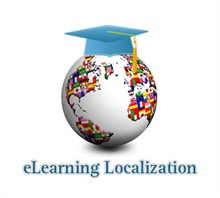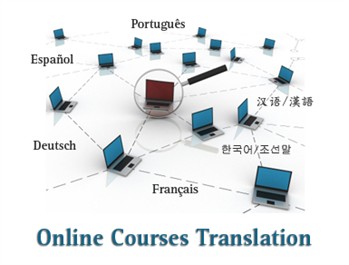Localization challenges in translating eLearning content
Ask someone: “What is eLearning” and chances are you will get as many different responses as the number of people you ask.

Asynchronous eLearning
Ask an academic and you’ll hear descriptions of online platforms, such as SABA/CentraOne, Clarity Net, Consensus, Learn.com, Moodle, SumTotal, Blackboard/WebCT that have ‘slots’ for posting content like lectures, documents and assignments; functionality for tracking students and grading papers; and mildly interactive features like discussion forums or chat rooms where students collaborate on team projects. In academics’ lingo, this is asynchronous elearning, where instructors and learners do not interact in ‘real time.’ Such platforms are supported by a learning and content management system (LMS, CMS or LCMS).
Synchronous eLearning
Ask a group of business people and they’ll most likely bemoan the pains of the last webinar they attended or, worse, the recorded one they were required to watch after they missed the live version! This is synchronous elearning, an electronic meeting place equipped with lower-level interactivity features like whiteboards and polling, where the instructors and learners interact in real time. You can record presentations, as well, to view later, basically converting the synchronous presentation to an asynchronous one.
Self-Paced eLearning
Ask the corporate trainer and he’ll tell you about his most recent accomplishment, converting a PowerPoint presentation into a self-paced course to replace, for example, the company’s bi-monthly classroom-based employee orientation program. This is called rapid elearning development, using elearning ‘authorware’.
Ask an instructional design team in India and they’ll tell you all about the storyboards, the Flash animations, the reusable learning objects, the coding, and…what, too much for you already?
The products of both of these approaches are self-paced online courses – one from a package; the other custom built- but neither involves an instructor. Instead, however, the instructional designer is tasked with emulating a learning environment.
![]()
The Localization Challenges – Asynchronous eLearning
Let’s define localization services as it refers to eLearning. Localization has many technical aspects, as you know, such as addressing text expansion and accommodating character-based languages. In addition, you are likely familiar with the concept of using culturally customized or appropriate images (including icons and symbols). For instance, the French version of an eLearning ethics course on “Accepting Gifts” may include an image of an employee in France accepting a bottle of wine; whereas the Hindu version of the same course has a picture of an Indian employee accepting an iPad, reflecting cultural differences.
However, eLearning localization goes beyond technology and images. We look at each eLearning course from one of the most important perspectives; from that of the targeted learners. Why? Because your goal – and ours – is to ensure that your courses deliver equitable learning outcomes for all users, no matter what their culture or language. When we translate or localize eLearning courses, we propose modifications based on what is culturally appropriate for the targeted learners.
Each type of eLearning has unique challenges; ones that are not simply technical, but related to the how, and where, and to whom the courses will be provided. Let’s look at some examples today from the asynchronous learning environment that is so popular with American online universities.
Asynchronous platforms present multiple localization challenges because they reflect our American educational system and subsequently, our values. Some of those features are impossible to address without redesigning the platform itself, so let’s talk about aspects that we can modify to meet the needs of non-American students.
For instance, the collaboration features of these platforms indicate that we expect students, via well-designed interactions, to ‘construct’ meaning. Our western adult learning theories also tell us that adults learn by sharing their experiences in this process. However, in many other cultures such as Asian ones, students expect their instructors to be subject matter experts (SMEs) and thus, in university courses, professors typically pass their knowledge down to their students via lecture. Students often memorize content and professors assess them on their ability to recall it. In contrast, American students are encouraged to generate their own knowledge, to apply it to their needs, and to experiment with what they have learned. Professors expect them to gather information and resources and assess students on how well they apply them. Thus, when Asian students enroll in American university courses, they may be suspicious of – and unwilling to participate in – these facilitated, collaborative activities. They ask themselves: Is the instructor lazy? Inept? Unqualified? What can my classmates tell me that the instructor cannot? Why would I pay to learn from other students? Thus, the questions to you are: How do you localize the role of the instructor? How do you localize an instructional technique?
Another challenge related to this one is that Asian countries and cultures tend to be very hierarchical. Thus, in a university setting, a student would never question the professor or challenge what has been said. Content is typically consumed verbatim. In contrast, Americans are from a very egalitarian culture and students expect to interact with a professor in the same way in which they engage their classmates: Whenever they want, when needed, and even in a challenging manner, if so required. How do you localize relationships?

With respect to content, American instructors rarely realize that their content could be irrelevant or out of context for non-American students. Instead, they assume that a topic such as statistics, for example, is a ‘black and white’ science and therefore, bereft of cultural influences. However, content is a cultural artifact and thus, it is embedded with our cultural values and nuances. Often, you can easily recognize American content that requires localization services. For example, if a statistics problem addresses how too much variability (standard error) in the ingredients of Flintstones vitamins creates problems, it’s easy to localize Flintstone vitamins to something more globally (or locally) recognized… or remove the reference entirely. In contrast, a problem that requires learners to survey the real estate data from the multiple listing services (MLS) in their local newspaper takes more effort to localize. Very few countries outside of the United States have an MLS, so the approach becomes ineffective or useless. How do you localize content – at the instructional design level – before you pay for translation and technical localization?
Our final example relates again to content. The words themselves (jargon, colloquialisms, etc.), how we write (content organization, approach, etc.), and how we structure our content (grammar, sentence structure, punctuation), all affect how learners absorb content. When writers use too many words, unfamiliar terminology, complicated sentences, etc., all learners, but particularly non-native English speakers, spend significantly more time and effort reading, re-reading, (misreading), and interpreting content. Chinese learners in MBA courses have reported taking 4 times longer to read course materials than their American counterparts! In some cases, culturally inappropriate words may actually alienate learners. In most cases, content can be edited by 30-50% to not only retain meaning but to improve it. How do you globalize your language to maximize comprehension while facilitating translation?
Conclusion About eLearning Localization
In all of these scenarios, situations existed that inhibited the achievement of equitable learning outcomes. “Equitable learning” means that all learners, despite their cultural differences, use the same amount of time and effort to generate the same knowledge and skills. From the perspective of the targeted learners, such eLearning courses may be ineffective, irrelevant, or even erroneous. From the perspective of educational institutions, such courses waste resources (time, financial, and human) and potentially generate risk with an untrained workforce.
These examples from the asynchronous learning environment illustrate the need to localize elearning from the perspective of media, methodology, and content. Next time, I’ll review the localization challenges in the related yet different environment of self-paced elearning.
eLearning Localization and Translation Services
GPI, a premiere translation company, provides comprehensive localization and translation services for eLearning and training courses. Our elearning localization team will help you translate your elearning courses and presentations in all languages.
